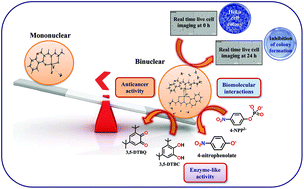Thiosemicarbazone(s)-anchored water soluble mono- and bimetallic Cu(ii) complexes: enzyme-like activities, biomolecular interactions, anticancer property and real-time live cytotoxicity†
Abstract
The reactions of CuCl2·2H2O with chromone thiosemicarbazone ligands containing a –H or –CH3 substituent on terminal N yielded monometallic Cu(II) complexes [Cu(HL1)Cl2] (1) and [Cu(HL2)Cl2] (2), whereas bimetallic Cu(II) complexes [Cu(μ-Cl)(HL3)]2Cl2 (3), [Cu(μ-Cl)(HL4)]2Cl2 (4) and [Cu(μ-Cl)(L5)]2 (5) were obtained when a –C2H5, –C6H11 or –C6H5 substituent was present, respectively, in the ligands. The complexes were characterized using elemental analyses, UV-Vis, FT-IR, EPR, mass and TGA studies. The structures of neutral monometallic and dicationic bimetallic complexes were confirmed by single crystal X-ray diffraction, and they exhibited a distorted square pyramidal geometry around Cu(II) ions. The catecholase-mimicking activity of complexes 1–5 was examined spectrophotometrically, and the results revealed that all the complexes except 5 had the ability to oxidize 3,5-di-tert-butylcatechol (3,5-DTBC) to 3,5-di-tert-butylquinone (3,5-DTBQ) under aerobic conditions with moderate turnover numbers. In order to find the possible complex–substrate intermediates, a mass spectrometry study was carried out for complexes 1–4 in the presence of 3,5-DTBC. The phosphatase-like activity of 1–5 was also investigated using 4-nitrophenylphosphate (4-NPP) as a model substrate. All the complexes exhibited excellent phosphatase activity in DMF-H2O medium. The complexes displayed significant biomolecular interactions and antioxidant potential. Complex 3 showed good interaction with apoptotic CASP3 protein, VEGFR2 and PIM-1 kinase receptors as revealed by a molecular docking study. Complexes (3–5) exhibited promising cytotoxicity against HeLa-cervical cancer cells with IC50 values of 2.24 (3), 2.25 (4) and 3.77 (5) μM, respectively, and showed a two-fold higher activity than cisplatin. The active complex 3 showed complete inhibition of colony formation at 10 μM concentration. In addition, the acridine orange (AO)/ethidium bromide (EB) staining and real-time live cell imaging results confirmed that complex 3 induced cell death in HeLa cells.



 Please wait while we load your content...
Please wait while we load your content...